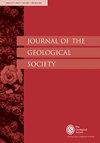Band-e-Zeyarat蛇绿岩(Makran增生楔,伊朗东南部)从洋中脊到增生杂岩的旅程:来自其沉积盖层和相关玄武岩脉和岩脊的新见解
IF 3
3区 地球科学
Q2 GEOSCIENCES, MULTIDISCIPLINARY
引用次数: 0
摘要
伊朗东南部Makran增生棱镜区Band-e-Zeyarat蛇绿岩(BEZO)沉积盖层记录了一个复杂的构造-沉积演化过程,从洋中脊形成到增生棱镜变形。地层学和生物地层学资料表明,该区存在一个分离火山层序和远洋沉积盖层的瓦兰吉尼亚过渡带层序。后者由下郝里维统cherty灰岩向上延伸至上郝里维统-巴雷米统泥灰岩和灰岩组成。上层沉积盖层继续为后巴雷米亚-塞诺曼尼亚期(?)泥灰岩。砂质岩在沉积盖层中呈层间分布;它们由来自火山弧和大陆边缘环境的岩石碎片组成。BEZO沉积盖层被岩脉和岩台侵入,显示出丰富的洋中脊玄武岩化学亲和作用。构造分析表明该区具有断裂和褶皱的多期变形史。我们的多学科研究结果表明,BEZO形成于MOR环境,随后在远离MOR的过程中受到离轴和板内岩浆活动的叠加作用。晚白垩世晚期—古新世,band - zeyarat洋壳被合并到Makran三棱镜中,中新世—上新世,band - zeyarat洋壳进一步沿右旋Minab-Sabzevaran断裂走滑变形。专题收藏:本文是蛇绿岩、杂岩和蓝片岩收藏的一部分,可在:https://www.lyellcollection.org/topic/collections/ophiolites-melanges-and-blueschists补充材料:https://doi.org/10.6084/m9.figshare.c.6843835本文章由计算机程序翻译,如有差异,请以英文原文为准。
The journey of the Band-e-Zeyarat ophiolite (Makran Accretionary Wedge, SE Iran) from the mid-ocean ridge to the accretionary complex: New insights from its sedimentary cover and associated basaltic dykes and sills
The Band-e-Zeyarat ophiolite (BEZO) sedimentary cover in the Makran Accretionary Prism (SE Iran) records a complex tectono-sedimentary evolution, extending from its formation at a mid-ocean ridge setting to deformation in an accretionary prism. Stratigraphic and biostratigraphic data indicate the occurrence of a Valanginian transition zone sequence separating the volcanic sequence and pelagic sedimentary cover. The latter consists of lower Hauterivian cherty limestone passing upwards to upper Hauterivian – Barremian marl and limestone. The pelagic sedimentary cover continues with post-Barremian – Cenomanian (?) marls. Arenites are interlayered in the sedimentary cover; they are composed of rock fragments derived from volcanic arc and continental margin settings. The BEZO sedimentary cover is intruded by dykes and sills showing enriched mid-ocean ridge (MOR) basalt chemical affinity. Structural analysis indicates a polyphase deformation history that involved faulting and folding. Our multidisciplinary results indicate that the BEZO formed in a MOR setting and that it was subsequently overprinted by off-axis and within-plate magmatism as it spread away from this MOR. The Band-e-Zeyarat oceanic crust was incorporated into the Makran prism in the latest Late Cretaceous – Paleocene, and was further deformed via strike-slip faulting along the dextral Minab-Sabzevaran fault during the Miocene - Pliocene. Thematic collection: This article is part of the Ophiolites, melanges and blueschists collection available at: https://www.lyellcollection.org/topic/collections/ophiolites-melanges-and-blueschists Supplementary material: https://doi.org/10.6084/m9.figshare.c.6843835
求助全文
通过发布文献求助,成功后即可免费获取论文全文。
去求助
来源期刊

Journal of the Geological Society
地学-地球科学综合
CiteScore
6.00
自引率
3.70%
发文量
68
审稿时长
6-12 weeks
期刊介绍:
Journal of the Geological Society (JGS) is owned and published by the Geological Society of London.
JGS publishes topical, high-quality recent research across the full range of Earth Sciences. Papers are interdisciplinary in nature and emphasize the development of an understanding of fundamental geological processes. Broad interest articles that refer to regional studies, but which extend beyond their geographical context are also welcomed.
Each year JGS presents the ‘JGS Early Career Award'' for papers published in the journal, which rewards the writing of well-written, exciting papers from early career geologists.
The journal publishes research and invited review articles, discussion papers and thematic sets.
 求助内容:
求助内容: 应助结果提醒方式:
应助结果提醒方式:


